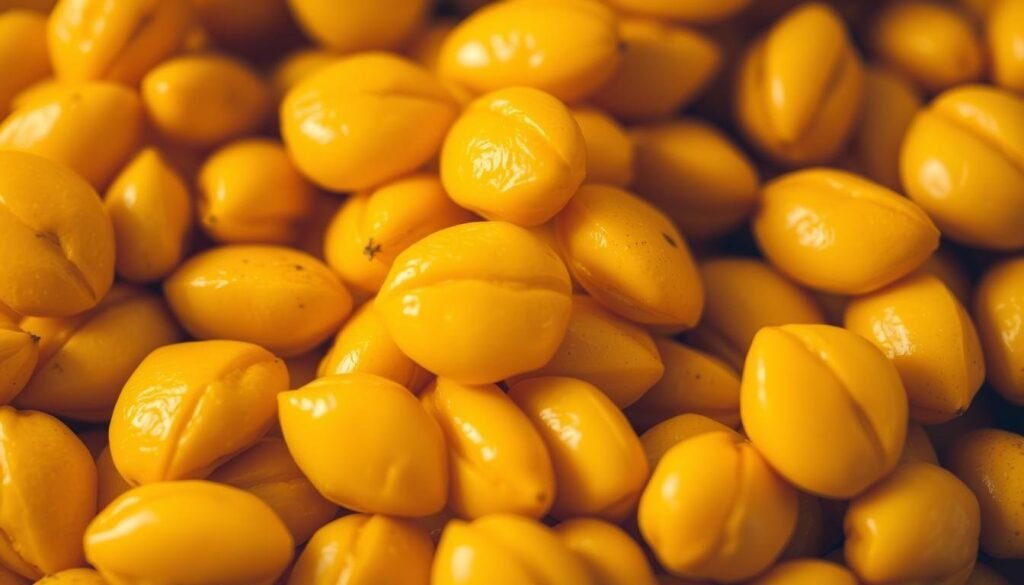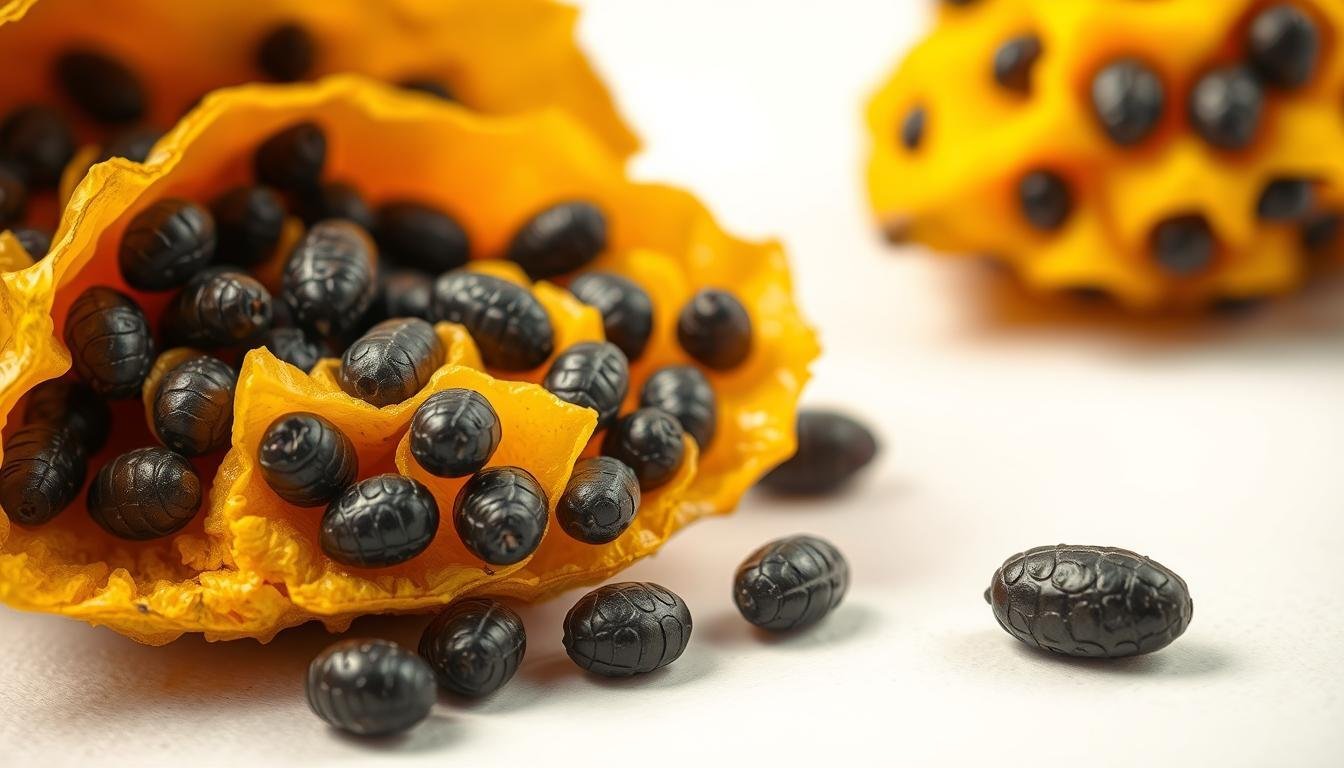Can You Eat the Seeds of Granadilla? When you enjoy the tropical fruit granadilla, you might find its seeds. But are these seeds safe to consume?
Granadilla comes from South America and has a sweet, tangy pulp around its seeds. While people love the pulp, they often wonder if the seeds are okay to eat.
Knowing if granadilla seeds are safe to eat is important. It helps those who want to enjoy the fruit without health worries.
Contents
- 1 What is Granadilla?
- 2 Can You Eat the Seeds of Granadilla?
- 3 Nutritional Benefits of Granadilla Seeds
- 4 Ways to Enjoy Granadilla Seeds
- 5 Conclusion: Can You Eat the Seeds of Granadilla?
- 6 FAQ
- 6.1 Are granadilla seeds safe to eat?
- 6.2 What are the nutritional benefits of granadilla seeds?
- 6.3 How can I incorporate granadilla seeds into my diet?
- 6.4 Are there any potential allergic reactions or risks associated with eating granadilla seeds?
- 6.5 Can I eat granadilla seeds raw?
- 6.6 How do I store granadilla seeds?
What is Granadilla?
Granadilla is a tropical fruit that’s becoming more popular. It’s known for its unique taste and health benefits. This fruit comes from tropical areas and is packed with vitamins and minerals.
So, what does granadilla taste like? It’s like a mix of pineapple, strawberry, and kiwi. This makes it a tasty and refreshing option.
Granadilla has a soft, juicy inside and a hard outer shell. It’s usually round or oval and varies in size.
Let’s look at granadilla’s nutritional values:
| Nutrient | Value per 100g |
|---|---|
| Vitamin C | 30mg |
| Potassium | 350mg |
| Fiber | 2g |
People enjoy granadilla fresh, in juices, or as a topping for desserts. Its unique taste and health perks are why it’s gaining fans.
In short, granadilla is a nutritious and tasty tropical fruit. Its rich nutrients and versatility make it a hit among fruit lovers.
Can You Eat the Seeds of Granadilla?
Many people wonder if they can eat granadilla seeds. They love the sweet and tangy taste of granadilla. But, there’s confusion about eating its seeds.
Granadilla seeds are not only safe to eat but also full of nutrients. They have dietary fiber, protein, and healthy fats. Eating these seeds can help with digestion and improve nutrient absorption.
Some benefits of eating granadilla seeds include:
- Increased fiber intake, which can aid in digestion
- Antioxidant properties that help protect against cell damage
- Potential anti-inflammatory effects
Even though granadilla seeds are safe, some might have allergic reactions. Symptoms can be itching, swelling, or stomach issues.
It’s always a good idea to introduce new foods gradually and in moderation to monitor your body’s response. If you experience any adverse reactions after eating granadilla seeds, it’s best to consult with a healthcare professional.

In summary, granadilla seeds are not only edible but also offer several nutritional benefits. By incorporating them into your diet, you can enhance your nutrient intake and potentially improve your overall health.
To enjoy granadilla seeds, you can simply eat them as is, or you can incorporate them into various dishes such as salads, smoothies, or baked goods. The versatility of granadilla seeds makes it easy to reap their benefits in a variety of ways.
Nutritional Benefits of Granadilla Seeds
Granadilla seeds are packed with fiber, antioxidants, and other nutrients. They are a healthy choice for any diet. Adding these seeds to your meals can boost your nutrition.
They are full of dietary fiber, which aids digestion. They also have antioxidants that fight oxidative stress and inflammation.
The nutritional benefits of granadilla seeds are many. They are high in fiber, which can lower cholesterol and improve heart health. The antioxidants in these seeds protect cells, reducing the risk of diseases like cancer and heart disease.
Key Nutrients in Granadilla Seeds
- Dietary Fiber: Promotes digestive health and satiety.
- Antioxidants: Protects against oxidative stress and inflammation.
- Essential Minerals: Supports various bodily functions, including immune response and energy production.
It’s easy to add granadilla seeds to your diet. Sprinkle them on salads, blend into smoothies, or top yogurt or oatmeal. Their versatility makes it simple to enjoy their health benefits in many dishes.
| Nutrient | Benefit | Effect on Health |
|---|---|---|
| Fiber | Promotes digestive health | Improves bowel movements and prevents constipation |
| Antioxidants | Protects against oxidative stress | Reduces the risk of chronic diseases like cancer and heart disease |
| Essential Minerals | Supports bodily functions | Enhances immune response and energy production |
The health benefits of granadilla seeds go beyond nutrition. They can add nutrition to many meals, boosting overall health. Knowing what’s in granadilla seeds helps you make smart diet choices.
Ways to Enjoy Granadilla Seeds
Granadilla seeds are not just nutritious; they’re also versatile ingredients for many dishes. You can add them to your diet in various ways, from sweet treats to savory meals.
Smoothies and Beverages
Add granadilla seeds to your favorite smoothie recipe for a nutritional boost. They blend well with fruits like bananas and berries, creating a delicious and healthy drink. You can also use them in juices and other beverages for added texture and nutrition, making it a great way to start using granadilla seeds in recipes.
Desserts and Baked Goods
Granadilla seeds can be used in baked goods like muffins, cakes, and cookies. They add a crunchy texture and a burst of flavor. Try incorporating them into your favorite dessert recipes for a nutritious twist on classic treats, perfect for experimenting with granadilla seed recipes.
You can also use granadilla seeds in savory dishes like salads, stir-fries, and curries. They add a unique texture and flavor that complements a variety of ingredients. Experiment with different recipes to find your favorite ways to use granadilla seeds in savory cooking.
Jams and Preserves
Granadilla seeds can be used to make delicious jams and preserves. Simply cook the seeds with some sugar and pectin (optional) to create a tasty spread that’s perfect for toast, yogurt, or as a filling for cakes and pastries. This is another great way to enjoy granadilla seeds, by making your own granadilla seed recipes at home.
Here’s a simple table to help you get started with incorporating granadilla seeds into your diet:
| Recipe Type | Idea | Benefits |
|---|---|---|
| Smoothies | Add to fruit smoothies | Boosts nutrition and texture |
| Baked Goods | Use in muffins and cakes | Adds crunch and flavor |
| Savory Dishes | Add to salads and stir-fries | Unique texture and flavor |
| Jams and Preserves | Make into homemade jam | Delicious spread for toast and yogurt |
By incorporating granadilla seeds into your recipes, you can enjoy their nutritional benefits in a variety of delicious ways. Experiment with different ideas to find your favorite methods for using granadilla seeds in recipes.
Conclusion: Can You Eat the Seeds of Granadilla?
Granadilla seeds are not only safe to eat but also full of good stuff. They help your digestion and give you important vitamins and minerals. You can easily add them to your meals by eating them raw, roasting them, or mixing them into your favorite dishes.
Granadilla seeds make your food better in two ways: they’re good for you and taste great. Adding them to your food is a smart move towards eating healthier. They’re a great way to boost your daily nutrition.
In short, eating granadilla seeds can really improve your health. You can make them a regular part of your meals and enjoy their benefits every day.
See Also: Can You Eat the Seeds of Horned Melon?
FAQ
Are granadilla seeds safe to eat?
Yes, granadilla seeds are safe to eat. They are full of fiber, antioxidants, and other important nutrients.
What are the nutritional benefits of granadilla seeds?
Granadilla seeds are packed with fiber, antioxidants, and other nutrients. They help with digestion and may reduce inflammation.
How can I incorporate granadilla seeds into my diet?
Add granadilla seeds to smoothies, baked goods, and savory dishes. You can also make jams and preserves with them. They’re a nutritious and versatile ingredient.
Are there any potential allergic reactions or risks associated with eating granadilla seeds?
Some people might be allergic to granadilla seeds, but it’s rare. If you have a bad reaction, stop eating them and talk to a doctor.
Can I eat granadilla seeds raw?
Yes, you can eat granadilla seeds raw. They add a crunchy texture and a nutty flavor to dishes.
How do I store granadilla seeds?
Keep granadilla seeds in an airtight container in a cool, dry place. This helps keep their nutritional value and flavor.

Hello, I am Bellamy George, a certified nutritionist and food safety specialist from Springfield, IL. With a degree in Food Science, I share research-backed insights on edible foods, seeds, and seafood for safe, informed eating.

